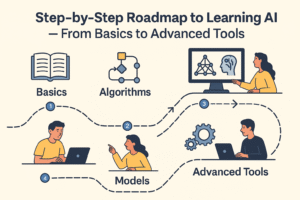
Introduction – The New Career Superpower
Think of AI as your smartest (but slightly literal) intern. If you tell it, “Make me something for work,” you’ll get something… random. But if you say, “Create a 200-word LinkedIn post in a witty tone about sustainable fashion for millennials,” suddenly your AI intern becomes a genius.
That’s prompt engineering in action — the art of giving AI exactly the right instructions to get exactly the right results. And in today’s workplace, it’s not just for techies — it’s for everyone.
What Is Prompt Engineering & Why It Matters
Prompt engineering is the practice of crafting precise, clear, and context-rich inputs for AI tools like ChatGPT, Claude, or Gemini so they deliver your intended output, not their best guess.
Why it’s becoming a must-have skill:
- AI is in every department – from HR to marketing to product design.
- Better prompts save time – a 2-minute tweak can save hours of edits.
- It’s a career differentiator – those who can “speak AI” stand out.
McKinsey research shows that companies who master AI prompting see up to a 40% increase in workflow efficiency. Imagine what that means for your daily tasks.
Core Prompting Techniques Every Professional Should Know
1. Zero-Shot Prompting – No examples, just direct instructions.
Example: “Write a 50-word elevator pitch for a vegan bakery.”
2. Few-Shot Prompting – Show a couple of examples first.
Example: “Here are two witty tweets I wrote. Write a third in the same style.”
3. Chain-of-Thought Prompting – Make the AI explain its reasoning.
Example: “Explain step-by-step how to plan a product launch.”
4. Role Prompting – Assign a persona to the AI.
Example: “Act as a career coach. Suggest three strategies for negotiating a higher salary.”
5. Constraint-Based Prompting – Set rules for tone, word count, or format.
Example: “Summarize this report in bullet points, under 150 words, in a formal tone.”
Role-Based Prompt Engineering: Practical Examples
Marketers & Content Creators
- Social Campaign: “Act as a TikTok strategist. Create 5 short video ideas for promoting an eco-friendly water bottle.”
- Blog Brainstorm: “Generate 10 blog topic ideas for a travel website targeting digital nomads.”
HR, Operations & Management
- Policy Draft: “As an HR manager, write a concise work-from-home policy with guidelines for attendance and communication.”
- Performance Review Summary: “Summarize 20 employee feedback forms into 5 main themes.”
Educators & Trainers
- Lesson Plan: “Act as a university lecturer. Create a 1-hour lesson plan on digital marketing basics.”
- Quiz Creation: “Generate 15 multiple-choice questions on world history with answers.”
Developers & Tech Professionals
- Code Debugging: “Review this Python script and explain potential optimizations.”
- API Documentation: “Write REST API documentation for a login authentication system.”
Freelancers & Career Starters
- Proposal Writing: “Draft a project proposal for a freelance web design project targeting small businesses.”
- Interview Prep: “List 10 common questions for a marketing associate role with strong sample answers.”
Prompt Templates to Save You Time
- Role + Task: “Act as a [role]. [Do the task].”
- Context + Goal: “Given [context], create [goal] in [format].”
- Step-by-Step: “Explain step-by-step how to [process].”
💡 Pro Tip: Add audience, tone, and format constraints for sharper results.
Best Practices & Mistakes to Avoid
✅ Be Specific: Give the AI details about audience, format, and tone.
✅ Add Context: Mention background info if relevant.
✅ Iterate: Treat prompts like drafts — refine until the output fits.
❌ Don’t Be Vague: “Write something about sales” will give you fluff.
❌ Avoid Overcomplicating: Too many instructions can confuse AI.
❌ Don’t Skip Review: Always fact-check AI outputs.
The Future of Prompt Engineering
AI is becoming more intuitive, but human-guided prompting will remain crucial. As tools evolve, prompts may become richer, even voice-based, but professionals who know how to direct AI will have the upper hand.
Gartner predicts that by 2027, prompt engineering will be a top-five skill in over 70% of corporate job descriptions. Learning it now means staying ahead of the curve.
FAQs
Q: Is prompt engineering only for tech professionals?
No — it’s valuable for marketers, HR, educators, managers, and anyone using AI.
Q: How long does it take to learn?
The basics can be learned in a day, but mastery comes from ongoing practice.
Q: Can AI write its own prompts?
Yes, but human oversight ensures relevance and accuracy.
Also Read: Use AI to Speed Up Content Creation Without Losing Quality


